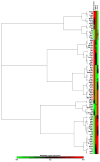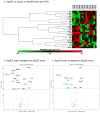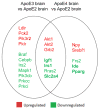Human ApoE Isoforms Differentially Modulate Glucose and Amyloid Metabolic Pathways in Female Brain: Evidence of the Mechanism of Neuroprotection by ApoE2 and Implications for Alzheimer's Disease Prevention and Early Intervention
- PMID: 26402005
- PMCID: PMC5485924
- DOI: 10.3233/JAD-150348
Human ApoE Isoforms Differentially Modulate Glucose and Amyloid Metabolic Pathways in Female Brain: Evidence of the Mechanism of Neuroprotection by ApoE2 and Implications for Alzheimer's Disease Prevention and Early Intervention
Abstract
Three major genetic isoforms of apolipoprotein E (ApoE), ApoE2, ApoE3, and ApoE4, exist in humans and lead to differences in susceptibility to Alzheimer's disease (AD). This study investigated the impact of human ApoE isoforms on brain metabolic pathways involved in glucose utilization and amyloid-β (Aβ) degradation, two major areas that are significantly perturbed in preclinical AD. Hippocampal RNA samples from middle-aged female mice with targeted human ApoE2, ApoE3, and ApoE4 gene replacement were comparatively analyzed with a qRT-PCR custom array for the expression of 85 genes involved in insulin/insulin-like growth factor (Igf) signaling. Consistent with its protective role against AD, ApoE2 brain exhibited the most metabolically robust profile among the three ApoE genotypes. When compared to ApoE2 brain, both ApoE3 and ApoE4 brains exhibited markedly reduced levels of Igf1, insulin receptor substrates (Irs), and facilitated glucose transporter 4 (Glut4), indicating reduced glucose uptake. Additionally, ApoE4 brain exhibited significantly decreased Pparg and insulin-degrading enzyme (Ide), indicating further compromised glucose metabolism and Aβ dysregulation associated with ApoE4. Protein analysis showed significantly decreased Igf1, Irs, and Glut4 in ApoE3 brain, and Igf1, Irs, Glut4, Pparg, and Ide in ApoE4 brain compared to ApoE2 brain. These data provide the first documented evidence that human ApoE isoforms differentially affect brain insulin/Igf signaling and downstream glucose and amyloid metabolic pathways, illustrating a potential mechanism for their differential risk in AD. A therapeutic strategy that enhances brain insulin/Igf1 signaling activity to a more robust ApoE2-like phenotype favoring both energy production and amyloid homeostasis holds promise for AD prevention and early intervention.
Keywords: Alzheimer’s disease; apolipoprotein E2; apolipoprotein E3; apolipoprotein E4; early intervention; glucose metabolism; glucose transporter 4; insulin-degrading enzyme; insulin-like growth factor 1; peroxisome proliferator-activated receptor gamma.
Figures





Similar articles
-
Human ApoE Isoforms Differentially Modulate Brain Glucose and Ketone Body Metabolism: Implications for Alzheimer's Disease Risk Reduction and Early Intervention.J Neurosci. 2018 Jul 25;38(30):6665-6681. doi: 10.1523/JNEUROSCI.2262-17.2018. Epub 2018 Jul 2. J Neurosci. 2018. PMID: 29967007 Free PMC article.
-
Opposing effects of viral mediated brain expression of apolipoprotein E2 (apoE2) and apoE4 on apoE lipidation and Aβ metabolism in apoE4-targeted replacement mice.Mol Neurodegener. 2015 Mar 5;10:6. doi: 10.1186/s13024-015-0001-3. Mol Neurodegener. 2015. PMID: 25871773 Free PMC article.
-
Differential interaction of Apolipoprotein-E isoforms with insulin receptors modulates brain insulin signaling in mutant human amyloid precursor protein transgenic mice.Sci Rep. 2015 Sep 8;5:13842. doi: 10.1038/srep13842. Sci Rep. 2015. PMID: 26346625 Free PMC article.
-
Apolipoprotein E and oxidative stress in brain with relevance to Alzheimer's disease.Neurobiol Dis. 2020 May;138:104795. doi: 10.1016/j.nbd.2020.104795. Epub 2020 Feb 6. Neurobiol Dis. 2020. PMID: 32036033 Free PMC article. Review.
-
The interaction of amyloid-beta with ApoE.Subcell Biochem. 2005;38:255-72. doi: 10.1007/0-387-23226-5_13. Subcell Biochem. 2005. PMID: 15709483 Review.
Cited by
-
ApoE isoform-dependent effects of xanthohumol on high fat diet-induced cognitive impairments and hippocampal metabolic pathways.Front Pharmacol. 2022 Oct 3;13:954980. doi: 10.3389/fphar.2022.954980. eCollection 2022. Front Pharmacol. 2022. PMID: 36278228 Free PMC article.
-
Perspectives in Lipocalin-2: Emerging Biomarker for Medical Diagnosis and Prognosis for Alzheimer's Disease.Clin Nutr Res. 2018 Jan;7(1):1-10. doi: 10.7762/cnr.2018.7.1.1. Epub 2018 Jan 17. Clin Nutr Res. 2018. PMID: 29423384 Free PMC article. Review.
-
Altered cerebral insulin response in transgenic mice expressing the epsilon-4 allele of the human apolipoprotein E gene.Psychoneuroendocrinology. 2017 Mar;77:203-210. doi: 10.1016/j.psyneuen.2016.11.028. Epub 2016 Nov 30. Psychoneuroendocrinology. 2017. PMID: 28088659 Free PMC article.
-
Peripheral versus Central Index of Metabolic Dysfunction and Associations with Clinical and Pathological Outcomes in Alzheimer's Disease.J Alzheimers Dis. 2017;60(4):1313-1324. doi: 10.3233/JAD-170263. J Alzheimers Dis. 2017. PMID: 28968233 Free PMC article.
-
Metabolic Dysregulation Contributes to the Progression of Alzheimer's Disease.Front Neurosci. 2020 Nov 5;14:530219. doi: 10.3389/fnins.2020.530219. eCollection 2020. Front Neurosci. 2020. PMID: 33250703 Free PMC article. Review.
References
-
- Thies W, Bleiler L. 2013 Alzheimer’s disease facts and figures. Alzheimers Dement. 2013;9:208–245. - PubMed
-
- 2014 Alzheimer’s disease facts and figures. Alzheimers Dement. 2014;10:e47–92. - PubMed
-
- Alzheimer’s Disease Education & Referral Center (National Institute on Aging) Alzheimer’s disease fact sheet. Alzheimer’s Disease Education & Referral (ADEAR) Center; Silver Spring, MD: 2008.
-
- Mullard A. Sting of Alzheimer’s failures offset by upcoming prevention trials. Nat Rev Drug Discov. 2012;11:657–660. - PubMed
Publication types
MeSH terms
Substances
Grants and funding
LinkOut - more resources
Full Text Sources
Other Literature Sources
Miscellaneous

